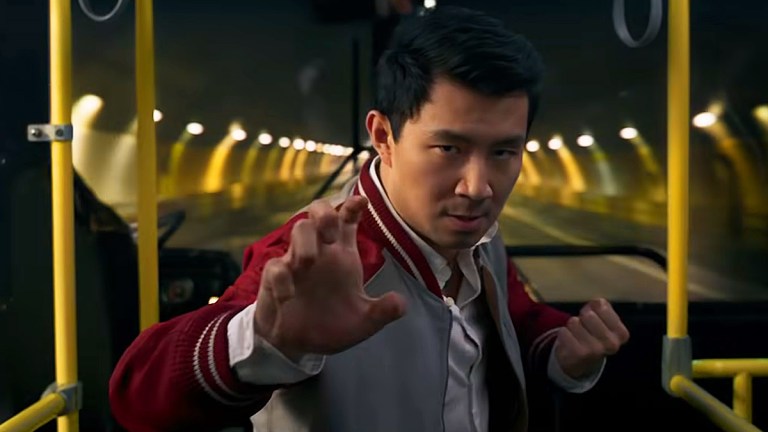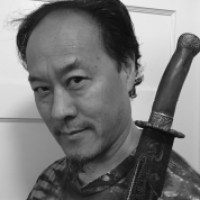The Real Martial Arts Behind Shang-Chi and the Legend of the Ten Rings
Shang-Chi and the Legend of the Ten Rings delivers real Kung Fu as a lasting testament to the legendary stunt coordinator, Brad Allan.

This article contains some minor spoilers for Shang-Chi and the Legend of the Ten Rings.
In the pages of Marvel Comics, Shang-Chi is known as the “Master of Kung Fu.” So when Marvel Studios announced the character to help usher in MCU Phase 4, the one thought on every fan’s mind was that whoever gets cast in the lead role better really know Kung Fu.
In the wake of Netflix’s Iron Fist, Marvel’s other Kung Fu master, there was a lot of skepticism. Marvel had scored with the previous Netflix series Daredevil, which delivered some of the best small screen fight choreography we’d ever seen. But Iron Fist was sorely lacking. Finn Jones just couldn’t sell a punch as Danny Rand, leaving fans of Marvel martial arts masters overwhelmingly disappointed. If there’s one thing that Shang-Chi and the Legend of the Ten Rings had to nail, it was the Kung Fu.
Like Jones, Simu Liu had little martial arts experience before taking on the role of Shang-Chi. However, he already had the physique, so much so that appearing shirtless was a running joke when he played Jung in Kim’s Convenience. What’s more, Liu bulked up, added 10 more pounds of muscle while training for the film.
Unlike a character like Daredevil, Shang-Chi doesn’t wear a mask, so Liu had to quickly pick up enough cinematic Kung Fu to appear masterful on screen. Fortunately, he was backed by a top-notch team of stuntmen and surrounded with a cast of veteran film fighters including Michelle Yeoh (Crouching Tiger Hidden Dragon, Star Trek: Discovery), Tony Leung (Hero, The Grandmaster), Yuen Wah (Kung Fu Hustle), Florian Munteanu (Creed II), Andy Le (The Paper Tigers), and others. Even though Liu was new to Kung Fu, he carries the action scenes with panache.
Shang-Chi and the Legend of the Ten Rings is not only a good Marvel movie, it’s a good Kung Fu movie. It has the best fight scenes seen in the MCU so far. And although the movie doesn’t get bogged down in the specifics of Kung Fu style, there are telling nods throughout the film that shows the filmmakers knew their Kung Fu too. “We knew the martial arts had to be authentic,” says Director Destin Daniel Cretton. “In order for that to feel real, we worked with people who understood Chinese Kung Fu.”
Let’s take a look at some of the Kung Fu roots and martial arts Easter Eggs underlying Shang-Chi and the Legend of the Ten Ringsdone.
The Ten Rings are Real…Kind of
Wenwu (Tony Leung) is the villain of Shang-Chi and the Legend of the Ten Rings, and he wields ten magical rings that he wears on his forearms. These are the source of his power, as well as the name of his criminal organization. The origin of these rings is a prevailing mystery in the movie; however, their inspiration is not.
Traditional Kung Fu practitioners use rings akin to these while training, particularly in Southern Chinese styles. Such rings are called tit waan in Cantonese, which literally means “iron rings” or “iron bracelets.” Iron rings are constructed of heavy metal, typically brass or steel, and are worn loosely on the forearms when practicing solo forms and doing arm drills.
They serve two purposes. Firstly, they are heavy, usually weighing over a pound a piece, so they act like wrist weights. Secondly, unlike Wenwu’s magical rings which conform to fit his forearms perfectly, real iron rings are looser. They must be narrow enough so that they stay on when the practitioner makes a fist, but they are far from form fitting. This gives them play to bang against the practitioner’s forearms when they are shadowboxing. The banging conditions the user’s forearms, hardening them to withstand the impact of blocking. Some iron ring practitioners have forearms that are so tough they can severely damage an adversary’s punch with their ring-hardened blocks.
Although iron rings are not conventionally considered as weapons, Kung Fu practitioners have figured out ways to weaponize just about everything. Some wield iron rings like brass knuckles, holding them in their fists for punching.
Kung Fu Hustle
Weaponized iron rings are used in the 2004 comedy Kung Fu Hustle. The character Tailor (Chiu Chi Ling) fights with them. Chiu is a genuine master of Hung Ga Kung Fu, a southern style that uses iron ring training extensively.
Director Destin Daniel Cretton claims that Kung Fu Hustle is one of his favorite martial arts movies so there are other nods to it in Shang-Chi and the Legend of the Ten Rings, including when a Kung Fu Hustle poster can be seen on a bedroom wall in the background. What’s more, Yuen Wah also appears as the warrior leader of Ta Lo who oversees Katy’s (Awkwafina) archery training. Yuen played the Landlord in Kung Fu Hustle and is a veteran martial arts actor with nearly 200 film credits. He is also the Kung Fu brother of Jackie Chan.
Yuen Qiu, who plays the Landlady in Kung Fu Hustle is a mutual Kung Fu sibling. Jackie, Yuen Wah and Yuen Qiu were all pupils of Yu Jim-Yuen, a master of Chinese opera who trained them all from childhood. They all took stage names that included the “Yuen” part of their master’s name (Jackie Chan was known as Yuen Lau as a child). Others among that troupe were many of the movers and shakers of Hong Kong’s golden age of Kung Fu films, such as Sammo Hung (a.k.a. Yuen Lung) and famed action choreographer, Yuen Woo-Ping (The Matrix, Crouching Tiger Hidden Dragon, Kill Bill).
Tiger Head Hooks
The signature weapons of the Ten Rings are Tiger Head Hooks. These are those black glowing hooked swords that the gang members wield. They also appear on the Ten Rings banner. It’s an excellent choice because Tiger Head Hooks are one of the most distinctively Kung Fu weapons of all.
In Chinese, these are called Hu tou shuang gou, which literally means “Tiger head paired hooks.” “Paired” because they are typically used in pairs. Sometimes they are just translated as Hook Swords. They have a sword blade with a hooked tip, a crescent-shaped blade for a knuckle guard, and a dagger blade for a pommel. Every edge is sharp. The only place they are not sharp is the handle. This makes them very difficult to wield. Consequently, Tiger Hooks are considered an advanced Kung Fu weapon.
The reference book Ancient Chinese Weapons by Dr. Yang, Jwing-Ming dates Tiger Head hooks back to China’s Spring Autumn Period (771-476 BCE), however those ancient hooks likely took on a different form. The modern style of Tiger Head hooks as seen in Shang-Chi and the Legend of the Ten Rings rose to prominence around the 1800s. They are still practiced today, mostly by Northern schools of Kung Fu.
What Style of Kung Fu Does Shang-Chi Practice?
Kung Fu is renowned for its diverse collection of styles like Shaolin, Wing Chun, Tiger style, and countless others. There’s even Drunken style and Toad style. In the movie, Shang-Chi doesn’t adopt a particular style of Kung Fu. Some of his moves have characteristics of Wing Chun or Bajiquan, but there’s nothing in the choreography to indicate a very specific style.
Avatar: The Last Airbender
The warriors of Ta Lo are different. While their style is not explicit, their peacekeeping philosophy is expressed through the soft, internal styles of Kung Fu like Tai Chi. When Ying Nan (Michelle Yeoh) schools Shang-Chi in their first match, it’s reminiscent of how airbending is depicted in Avatar: The Last Airbender.
However, the connection is deeper than that. Despite its fantasy elements, Avatar based its martial arts sequences on authentic Kung Fu by mo-capping Sifu Kisu, a renowned martial arts master. Kisu designated specific styles for each school of bending. Airbending was based upon an internal style of Kung Fu known as Baguazhang, or Eight Diagram Palm. Like Tai Chi, it has a soft expression. It relies on circular movements and pivoting evasions. Several of Yeoh’s techniques are plucked straight out of Baguazhang.
The Masters Behind Shang-Chi’s Martial Arts
Credit for Shang-Chi’s Kung Fu authenticity falls on the film’s top notch stunt team. Two are leading graduates of the legendary Jackie Chan Stunt Team. The fight on the hi-rise scaffolding is a homage to Jackie’s parkour-inspiring choreography. Andy Cheng worked on around half a dozen of Jackie’s films including his first two Rush Hour films, Shanghai Noon, The Tuxedo, and Who Am I? where Jackie does one of his all-time greatest stunts, sliding down the Willemswerf skyscraper in Rotterdam. He was also the action director for Into the Badlands. When Jackie inevitably stepped back from doing his own stunts, Cheng stepped in for him.
“We were very concerned [about Kung Fu] from the very beginning,” says Cretton. “Marvel was also concerned and wanted to get it right. [They] knew that Marvel fans, wouldn’t have let it slide if we did a Hollywood version of a whitewashed Kung Fu movie. To be able to, we brought in Brad Allan.” Brad Allan was the first non-Asian to make Jackie’s stunt team. He also worked on around a dozen of Jackie’s films (this is approximate because stunt work wasn’t always credited).
Who Was Brad Allan?
You can’t miss the credits in any MCU film. In Shang-Chi and the Legend of the Ten Rings, there’s a prominent dedication to Allan at the very end. Tragically, on August 7th, 2021, Brad Allan died unexpectantly at the early age of 48, sending the martial arts world reeling from the loss of one of its brightest stars. Beyond Shang-Chi, Allan leaves behind an exemplary legacy of action films where he served as the Second Unit Director including Scott Pilgrim vs. the World, Cuban Fury, Solo: A Star Wars Story, and the Kingsman trilogy.
Allan was obsessed with the martial arts from childhood and rose to compete internationally in Wushu, representing Australia where he was born and raised. Through a chance encounter, he was able to demonstrate his skills to Jackie, and Jackie liked what he saw so much that he took Allan under his wing.
In 1999, Allan played Alan, the villain in Jackie’s film Gorgeous, which coincidentally also stars Tony Leung. With Allan clad in black and Jackie in white, their finale fight is, well, it’s gorgeous. It’s two of the greatest masters of the craft delivering top notch fight choreography. Allan spent most of his career modestly behind the scenes, so Gorgeous is the outstanding example of his speed and agility. It’s heartbreaking that Allan didn’t get to see the premiere of Shang-Chi and the Legend of the Ten Rings.
Allan’s final work will be seen in The King’s Man later this year.
Shang-Chi and the Legend of the Ten Rings is now playing in theaters.
